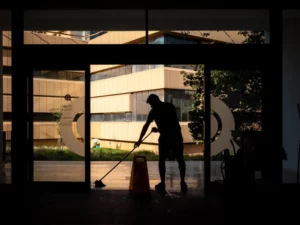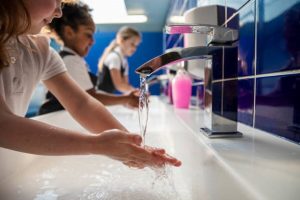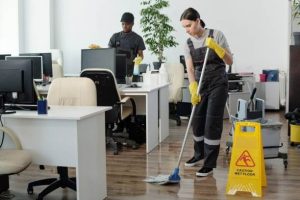Society’s impact on the environment has long been the topic of conversation across many industries, and in recent years consumers are beginning to push for environmental awareness when it comes to the products and services they choose. Approximately 88% of consumers desire products and services from companies that make an effort to be more sustainable and more eco-conscious. This desire for sustainability carries into the cleaning industry in multiple ways, but primarily when it comes to products, hazardous chemicals, and water usage. With floor care being one of the most complex and largest cleaning tasks in any space, practicing sustainable floor cleaning methods will preserve the appearance of your space, while causing minimal harm to the surrounding environment.
What Makes it Sustainable
Cleaning methods are considered “sustainable” when:
- they have been curated with the intention of doing as little harm to the environment as possible
- they are able to be consistently practiced in an safe manner without depleting resources
To aid in the mission for sustainable cleaning practices, the Environmental Protection Agency (EPA) has released two specific designating labels for cleaning products that have been proven to be less hazardous to the environment – the “Safer Choice” label program and the “Design for the Environment” label program. These labels help consumers easily identify if the cleaning products they buy are truly environmentally friendly or not when incorporating them into their cleaning routines.
Different Floors Require Different Care
Tile, wood, laminate, and carpet flooring all require different care methods. However, all four of these flooring types have cleaning methods that can be readily adapted for sustainable floor cleaning. When it comes to tile flooring, maintenance is relatively simple and there is a larger margin of error before damage occurs. When mopping tile you do not need to be concerned about causing water damage. Hardwood flooring is a bit trickier to care for as it is damaged easier than other floorings and more prone to scratches and water damage. However, wood flooring has the advantage of being able to be sanded down and refinished for repairs or upgrades. Laminate flooring can look like tile or wood, but the cleaning requirements for it are more complicated, because the laminate is incredibly susceptible to water damage and can only be mopped sporadically since the surface cannot be sanded and refinished. Carpet flooring cleaning methods differ the most from others, as the soft surface cannot be cleaned with a broom or mop, and instead typically requires additional tools such as a vacuum or carpet cleaning machine.
The Key to Sustainable Floor Care
Your sustainable floor care routine – no matter what kind you have – should have five main components:
- Pre-routine
- Routine maintenance
- Interim maintenance
- Partial restorative
- Complete restorative
The specifics of these different aspects of your floor care routine vary by flooring type, and aligning your sustainable floor care routine with these specific components is the best way to achieve maximum results.
Your flooring pre-routine accounts for the preventative measures you take to maintain the daily cleanliness of your floors. Practicing careful pre-routine methods, such as keeping entries to the facility clear of debris which can be tracked in or using entryway mats to pick up the debris before it makes it onto your floor, can be environmentally friendly by nature, as there are no chemicals or by-products involved which can contaminate the surrounding areas. When done consistently, pre-routine floor care can improve the sustainability of your overall floor care practices because it reduces the frequency at which you must deep clean the area, which in turn reduces the amount of overall water and chemicals needed to keep your floors looking sharp
The routine maintenance you conduct on your flooring takes the cleaning a step further, and often involves dust mopping, light/damp mopping, and vacuuming. Making your routine maintenance work with your sustainable floor care plan can be done quite easily, by focusing on methods that use little or no water and using products which are verified environmentally friendly by the EPA when cleaners are needed. Practicing consistent routine maintenance on your flooring reduces the amount of deeper cleaning needed, which is often when heavy water and hazardous product usage occurs in floor care. Routine maintenance plays a big role in any sustainable floor care plan, and when done correctly in collaboration with a consistent pre-routine, you can effectively reduce the impact your cleaning has on the surrounding environment.
Interim floor maintenance is typically when some of the more harmful products and practices are used. Interim maintenance often includes deep mopping, buffing and shining, shampooing, and steaming. These methods typically require the use of an appliance such as a power buffer or carpet shampooer. Likewise, these cleaning methods also typically require the use of substantial amounts of water and cleaning products. Just as with any products at any phase in your sustainable floor care plan, you should prioritize using cleaners which have been marked eco-friendly by the EPA. As for water usage, it is important to use only as much water as needed to get the job done. Using the correct cleaners, practicing presoaking for carpeted stains, and using tools or appliances which are designed to target hard stains and residue efficiently can help minimize the amount of water wasted. Additionally, being aware of how you dispose of the wastewater and by-products of your cleaning methods is crucial to having a completely sustainable floor care plan, as a significant amount of environmental harm can occur when waterways become polluted from wastewater dumping.
The more consistent and precise you are with your pre-routine, routine, and interim floor maintenance, the less you will have to conduct partial or complete restorative floor maintenance. Partial restorative and complete restorative floor care are more relevant for those owning hardwood or tile flooring, as those are the primary types which can be sanded, buffed, and/or refinished. A successful sustainable floor care plan should ideally only employ these processes when absolutely necessary, as typically the products and methods used to strip, prep, treat, and finish the flooring are incredibly hazardous.
There are measures that can be taken to reduce the harm done by heavier types of maintenance, but the tougher jobs ultimately require stronger, more dangerous products to successfully get the mess out. The key to making partial and complete restorative floor maintenance work for your sustainable floor care plan is to do so only when necessary (and with EPA approved products of course). Be diligent with your pre-routine, routine, and interim floor care maintenance.
Ready to Make a Difference?
Although floor cleaning is essential in any space, there are many steps that can be taken to reduce the impact your cleaning practices have on the environment. Sustainable floor care focuses on increasing the amount of preventative and routine care done, thereby reducing the amount of heavy restorative floor care needed, which is often the most harmful type of floor care. Following a sustainable floor care plan can be tricky, and hiring a professional commercial cleaner to take on your floor care can help you improve your sustainability while relieving you of the stress of tackling it on your own. Regardless of what type of flooring you need to care for, practicing a sustainable floor care plan can minimize your facility’s environmental impact while also preserving your floors.
About Partner Facility Solutions
With over 30 years in owners combined experience, Partner Facility Solutions has come together to create a company model that believes superior quality service can’t be compromised. Extensive training with intelligent supervision and ownership helps us keep a clear vision of our goals and commitment. Give us a call today for a free consultation and let us be the solution for your facility’s needs. We look forward to forming a partnership with you.





